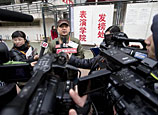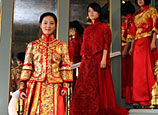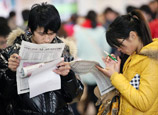
 |
| (Xinhua/Du Huaju) |
During this year’s two political sessions, all eyes will be on the world’s second largest economy. 2012 wasn’t an easy year with sluggish demand from major trading partners.
To regain momentum, the Chinese government is planning a transformation of its economic growth model. The goal is to put the country on a sustainable footing for the long term.
Back on track - Based on current figures, China’s Academy of Social Sciences is predicting an 8 percent rise in gross domestic product for the first quarter of this year. It seems there’s a bright outlook for economic growth.
The Chinese economy has long been propelled primarily by exports, and fixed investments. Now the country is gearing up to boost domestic consumption, and increase imports.
The growth pattern of the Chinese economy has seen great changes this year with consumption replacing investment to be GDP’s biggest contributor. Analysts say
with more stimulus measures in the pipeline, China’s retail sales looks bright in the near future and people may buy more value-added products as their disposable incomes rise.
A report by the Chinese Chamber of Commerce estimates that retail sales will grow by about 15 percent in 2013 - an increase on 14.3 percent in 2012.
The report mainly attributes the increase to upcoming government measures aimed at the logistics sector and small and medium-sized businesses. The continuing online shopping boom is also a key factor.
But some experts say lower taxes are also needed, to encourage spending.
Guozhong Zhu, assistant professor of Guanghua School of Mgmt, Peking Univ., said, "My research shows that income uncertainty is relatively high in China. That’s why Chinese people tend to save up for a rainy day rather than spend. I also believe the middle-income group is the main driving force behind China’s domestic consumer economy. So lower taxes are key; high housing and car taxes only serve to put pressure on consumers."
Chinese policy makers also say they’re determined to move towards an "Innovation-driven" economy. This goal was set out in a report delivered by President Hu Jintao to the 18th National Party Congress.
Chen Deming, Chinese Commerce Minister, said, "Economic reform mainly focuses on adjusting structure and changing the mode of economic development. China has a large export volume. We have to adjust our export structure, as well as foreign direct investment in China, and China’s overseas investment."
The Chinese economy has seen phenomenal growth since the late 1970s. The consensus view among Chinese scholars is that the country has grown by relying heavily on investment, exports, and a huge low-cost labor force.
Economists say the formula has worked well so far. But evidence indicates that China is profiting less and less from this approach.
Xu Sitao, chief china rep. of the Economist Group, said, "It’s a fact that the old model is not working. China is now a middle income country. So the cost structure is completely different. Therefore China must rely on domestic-led growth - mainly private consumption. At the same time, we must accept slower but better quality growth."
Experts say as a country gets richer, its growth formula must change. Innovation, technology, and productivity improvements become more important, along with a growth in domestic enterprise. In the past 20 years, China has invested heavily in Research and Development. This year, China will likely invest 2 percent of its GDP in R&D -- that’s a level attained by only a small number of rich countries.
















 Farmers in E China's Fujian prepare for spring sowing
Farmers in E China's Fujian prepare for spring sowing


![]()
